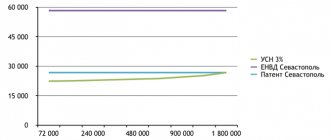The basis of entrepreneurship is the regular increase in the effectiveness of economic activities. Operational efficiency can be increased by optimizing the reporting process and reducing production costs. You can reduce business costs using special tax regimes. Only those entrepreneurs whose business meets the criteria established by regulatory authorities can take advantage of preferential taxation systems. This policy of the tax authorities is explained by the fact that preferential regimes cannot be applied in all areas of business. If it is impossible to switch to a special system, the entrepreneur is obliged to use the standard tax payment scheme. In this article we propose to consider the question of what the general taxation system is.
Decoding OSNO defines the concept of a general taxation system
BASIC: what is it
The term "OSNO" is an abbreviation and stands for general taxation system. According to experts, this tax regime is one of the most complex types of financial responsibility. This system includes a large number of different taxes and “forces” the entrepreneur to generate the most complete reports. These requirements apply not only to declarations, but also to financial statements. Companies operating under this scheme are required to pay more than four different types of taxes. In addition, it is necessary to take into account mandatory contributions to the state treasury for each company employee.
Business entities using this regime cannot use the various benefits available to payers who use special systems.
As a rule, this type of taxation is used by large companies. It is important to note that most businessmen can switch to using other tax payment regimes. To do this, you must send a written notification to the control authorities and obtain approval from the tax service. You can switch to other modes only if the company meets the parameters set by a special system. If a refusal is received, the entrepreneur will have to continue to use the general scheme or reorganize his company.
How does OSNO taxation work? ↑
As you know, making calculations and preparing reports on OSNO is quite difficult. Is it so? Let's figure out how to calculate taxes.
How to calculate the amount to be paid?
All tax calculations on the main system are carried out separately: separate formulas are used for VAT, property tax, etc.
Value added tax calculation
For example, you sell goods worth 11,800 rubles, and must pay tax at a rate of 18%. Of the total amount, you can take 10 thousand as profit, and 1.8 thousand is VAT. If you buy products for 1800, pay 180 in VAT, the rest as expenses.
Then you can calculate the remaining taxes. Income tax: from the amount of 10 thousand, subtract the costs (let's say 1 thousand) and multiply by 13% (or another rate that applies in your territorial district).
The calculation will be like this:
VAT: You received 1800 rubles, paid 180. VAT amount = 1620 rubles (the difference between the two indicators).
Making a payment
Taxes on OSNO must be paid within the following deadlines:
| Income tax | Until the 28th monthly, and the final annual payment – until 10/28. But there is one feature - payment is made every month in the case when the amount of profit exceeds 1,000,000 rubles per month. In other situations, you should pay tax once a quarter |
| VAT | Transfer each quarter in equal parts (advance payments) until the 20th of the next month after the reporting period |
| Personal income tax for employees | Upon actual receipt of cash or upon transfer of non-cash funds to the taxpayer’s account |
| Transport tax | Until 1.02 after the end of the tax period |
| Water tax | Quarterly |
| Land tax | Before February 1 in the year following the tax period |
| Payments to the Pension Fund | Until the 15th of the next month after the payment of earnings, that is, monthly |
| In the FSS | Until the 20th if paper reporting is submitted, until the 25th if electronic reporting is submitted |
| Amounts in the Compulsory Medical Insurance Fund | Quarterly until the 15th of each month |
| Property tax | By the 30th of each quarter (next month), and the final payment is due by October 30 |
| If the company’s activities are related to the sale of alcohol-containing goods | Every month you have to pay excise tax |
Drawing up accounting policies
Accounting policies must be drawn up for the purposes of accounting and carrying out activities on the SPE.
The following actions await you:
- Development of a draft accounting policy - the purpose is determined, the elements that will be used without fail are established, those that are undesirable for use are excluded, the content is prescribed.
- Approval of the document by a separate order of the enterprise administration.
The accounting policy is adopted once, and in the absence of changes, it is applied continuously. It is allowed to make clarifications and additions.
In relation to accounting, such a document is drawn up by an accountant, in relation to tax accounting - by the person who is responsible for its implementation.
For example, a company on OSNO operates in the field of trade. This means that when drawing up an accounting policy, it is worth considering the procedure for accounting for products and forming costs.
First, they indicate by what criteria the property object is included in the product. Often these are areas of use of assets - material inventories that were received for the purpose of sale.
How to find out the basic yield on UTII in 2015, see the article: table of basic yield on UTII. Is it possible to find out the tariff code in RSV-1 for 2015 using UTII via nalog.ru, read here.
Then reflect the accounting units. The next point is the assessment of products, the order of their receipt. They prescribe the features of accounting for transportation costs, carrying out wholesale sales operations, write-off methods, etc.
Main features of taxation
Business entities using the main tax payment scheme are required to comply with a special procedure for recording financial documents. This scheme includes several different taxes. It is important to note that the procedure for using OSNO for legal entities is somewhat different from the use of this system by private entrepreneurs. This factor must be taken into account by newcomers to the business world who are at the stage of choosing an organizational form for their project.
A unique feature of the system under consideration is the prohibition on the simultaneous use of OSNO with other taxation systems . The only exception is the simultaneous use of OSNO with the patent system or “imputation”. This rule is established by law. Entrepreneurs who want to use this system must carefully weigh all the pros and cons, having first studied all the mandatory payments included in this regime.
OSNO is a special tax calculation scheme for business entities
When is it profitable to switch to OSNO?
Based on the above, we can conclude that using the main taxation system is extremely unprofitable for most entrepreneurs. However, this opinion is erroneous. The use of this system is advisable in cases where an entrepreneur plans to cooperate with companies using this mode. The choice of such counterparties allows you to reduce the amount of mandatory contributions to the budget by the total amount of VAT received from the counterparty. In addition, companies using this system have the opportunity to enter into contracts with foreign companies. In this case, the company has the opportunity to reduce the amount of regular payments by deducting VAT, which is included in the final cost of imported and exported goods.
It is also advisable to use this mode if the selected area of primary activity belongs to the group of preferential areas. This category includes medicine, educational activities, the production of agricultural goods and social taxes. The benefits provided to companies operating in this area can significantly reduce tax costs.
In what cases is it beneficial to use OSNO?
Despite the fact that many enterprises are forced to use OSNO because they do not have the right to special regimes, there are those who deliberately do so.
First of all, OSNO is beneficial for companies and entrepreneurs who are involved in the VAT chain.
If a company works for OSNO and pays VAT, it is more profitable for it to buy goods and services from the same VAT payer, because he will issue an invoice with allocated VAT. The company will be able to deduct this amount and reduce its VAT payable. This is why large companies prefer OSNO counterparties and refuse to cooperate with those who apply a different regime. In order not to miss the “big fish,” it is sometimes more profitable to switch to a general taxation regime and endure the complexity of accounting.
In addition, it is beneficial for an organization to use OSNO if its type of activity falls under income tax benefits.
Taxes paid under OSNO
The main tax system is one of the most complex regimes, including several different types of taxes. It is important to note that these taxes are paid individually due to the fact that part of them is redirected to the regional treasury, and part to the federal budget. Before you start using this system, you need to familiarize yourself with the main components of this mode. You can obtain this information from tax authority employees or on the official website of this authority.
To the profit of the enterprise
The system under consideration includes several direct taxes. One of them is the tax on profits received by a legal entity. The twenty-fifth article of the Tax Code provides information on the procedure for calculating this tax. The rate for this tax is twenty percent of the company's total profit. To determine the size of the payment, it is necessary to multiply this indicator by the amount of the tax base.
Income tax has two main elements. Most of the amount paid by a legal entity is redirected to the regional budget. The remaining amount is intended for the federal treasury. It is important to note that local governments can provide various benefits to legal entities. You only need to pay this tax once during the year. Payment must be made before the twenty-eighth of March of the year following the reporting year. The current Tax Code obliges business entities to make quarterly advances. Advance payments are transferred until the twenty-eighth day of the month following the end of the quarter. Along with the funds, the entrepreneur must send reports on this tax.
Carrying out business activities in the OSNO mode implies the need to pay all legally required types of taxes, as well as maintaining special records of payment documentation
For the income of individuals
The OSNO tax system, in addition to the corporate profit tax, includes a tax on personal income. This tax is one of the direct payments, since the amount of payments is calculated based on the amount of income. Each company is required to independently calculate the amount of these contributions. Money received from business entities is redirected by the tax service to the federal treasury.
In order to determine the amount of the contribution, the entrepreneur needs to find the difference between the amount of income and the advances already transferred. When making calculations, the benefits provided for the company are taken into account. The result obtained must be multiplied by the rate of this tax. Today, the personal income tax rate is thirteen percent. This rule applies only to residents and citizens of our country.
A private entrepreneur acting in the status of an employer is obliged to transfer to the federal budget not only the income tax of his employees, but also for himself personally. This tax is paid once during the year. When paying, it is recommended to adhere to the following scheme:
- It is necessary to transfer funds to the state budget before the fifteenth of July of the year following the one in which the income was received. The only exception to this rule is the tax authority's requirement to make an advance payment.
- The first advance payment must be made at the end of the second quarter (before the fifteenth of July), the second advance payment is transferred at the end of the third quarter (before the fifteenth of October), and the last amount is paid at the end of the reporting year (before the fifteenth of January).
When paying this tax, an entrepreneur needs to fill out a declaration using the “3-NDFL” form. For business entities paying this tax for the first time, the “4-NDFL” form is provided.
For property
OSNO is one of the most complex tax systems, which includes, in addition to the above mandatory payments, property tax. In this case, the estimated value of assets on the company’s balance sheet is used as the tax base. The funds transferred by the entrepreneur are redirected by the tax authority to the local budget. It is important to note that private entrepreneurs do not need to independently prepare tax base calculations, since control authorities regularly send relevant notifications to companies.
Only legal entities need to do their own calculations. In order to determine the amount of the contribution, it is necessary to multiply the value of the assets by the rate established by the Federal Tax Service. The total amount of previously transferred funds should be subtracted from the result obtained. The property tax rate for individual entrepreneurs varies from one tenth to two percent of the cadastral value of real estate. For organizations, the rate is set at 2.2%.
OSNO is a tax regime for which there is no separate chapter in the Tax Code of the Russian Federation
Added value
In addition to direct tax payments, business entities using OSNO are required to pay indirect taxes. Value added tax falls into this category. Its value depends on the final cost of the commodity product, service provided or services rendered. Money received from entrepreneurs is redirected by the Federal Tax Service to the federal treasury. The amount of these payments depends on the total amount of revenue received through the sale of commercial products or the provision of services. The amount of input VAT must be subtracted from this value. This amount is determined on the basis of the counterparties' accounting reports. The amount of value added tax for restoration can be determined using Article One Hundred and Seventieth of the Tax Code of the Russian Federation. This document provides detailed procedures for making calculations.
General taxation regime (GTR)
In the Tax Code there is no such thing as a “general taxation system,” in contrast to special tax regimes, each of which is assigned a separate chapter with a corresponding name and a single tax. OSN is understood as a set of federal and regional taxes, such as value added tax, corporate income tax, corporate property tax, and personal income tax. These taxes are established by default from the moment of registration of a legal entity or individual entrepreneur, and therefore there is no need to submit any notifications to the tax authority. That is why it is customary to call such a taxation system general. The general tax regime is the most difficult for small and medium-sized businesses.
Under the general taxation regime, the following main taxes are calculated and paid:
| Entity | Individual entrepreneur |
Value added tax (VAT)
for the first quarter - until April 25, 2021; for the second quarter - until July 25, 2021; for the third quarter - until October 25, 2021; for the year - until March 25, 2022 | |
Corporate income tax
for the first quarter - until April 28, 2021; for the second quarter - until July 28, 2021; for the third quarter - until October 28, 2021; for a year - until March 28, 2022 | Personal income tax (NDFL)
|
Organizational property tax
for the first quarter - until April 30, 2021; for the second quarter - until July 30, 2021; for the third quarter - until October 30, 2021; for the year - until March 30, 2021 | Personal property tax (NDFL)
|
Approximate calculation of taxes under the general taxation regime for a legal entity:
The legal entity's income for the quarter amounted to 100,000 rubles, including 18% VAT, while expenses amounted to 50,000 rubles, including 18% VAT (according to invoices issued from counterparties), as well as 20,000 rubles, without taxation VAT. There are no movable or immovable property on the balance sheet.
VAT calculation:
100,000 rub. (income) - 50,000 rub. (expense including VAT) = 50,000 rub. (the tax base)
50,000 rub. (tax base): 100 * 18 (tax rate) = 9,000 rub. (VAT)
Calculation of corporate income tax:
When calculating income tax, the tax base is calculated without VAT, thus:
The organization's income without VAT was: 100,000 - 18% = 82,000 rubles.
the organization's expenses excluding VAT amounted to: (50,000 - 18%) + 20,000 = 61,000 rubles.
82,000 rub. (income) - 61,000 rub. (expense) = 21,000 rub. (the tax base)
21,000 rub. (tax base): 100 * 20 (tax rate) = 4,200 rub.
Total for all taxes: 9,000 rubles. (VAT) + 4,200 (profit) = 13,200 rub.
Approximate calculation of taxes under the general taxation regime for individual entrepreneurs:
An individual entrepreneur's income for the year amounted to 100,000 rubles, including VAT 18%, while expenses amounted to 50,000 rubles, including VAT 18% (according to invoices issued from counterparties), as well as 20,000 rubles, without taxation VAT. An individual entrepreneur does not have movable or immovable property.
VAT calculation:
100,000 rub. (income) - 50,000 rub. (expense including VAT) = 50,000 rub. (the tax base)
50,000 rub. (tax base): 100*18 = 9,000 rub.
Calculation of personal income tax (NDFL):
When calculating personal income tax, the tax base is calculated without VAT, thus:
The entrepreneur's income excluding VAT was: 100,000 rubles. — 18% = 82,000 rub.
the entrepreneur's expense excluding VAT was: (50,000 - 18%) + 20,000 = 61,000 rubles.
82,000 rub. (income) - 61,000 rub. (expense) = 21,000 rub. (the tax base)
21,000 rub. (tax base): 100*13 (tax rate) = 2,730 rubles.
Total for all taxes: 9,000 rubles. (VAT) + 2,730 (NDFL) = 11,730 rubles.
Reporting of LLCs operating under OSNO
We have already noted above that the procedure for using OSNO by legal entities is somewhat different from the use of this system by private entrepreneurs. The main difference is the reporting methods. According to established rules, all legal entities are required to regularly submit VAT declarations to employees of the fiscal service. In addition to this report, organizations must regularly fill out a declaration indicating the amount of profit received during the reporting period. These reports must be submitted by March twenty-eighth of the year following the reporting year. When using an advance system, the company must submit reports at the end of each quarter. Funds must be transferred at the time of reporting.
Along with the above tax reports, organizations need to pay property taxes. As mentioned earlier, legal entities independently make all the necessary calculations. It is important to note that local governments have the right to independently establish rules for submitting reports. This means that in some regions of our country, not annual reporting is provided, but a quarterly accounting scheme.
Filing a declaration ↑
An organization at OSNO must prepare several declarations:
- according to VAT;
- income tax;
- on property;
- for transport tax (if there is a vehicle);
- on land tax (if any);
- for personal income tax (form 3-NDFL);
- 4-NDFL.
How to fill out the document?
General rules for all types of declarations:
- You can fill out the form manually or through a program;
- You should only enter one value in one cell;
- dashes are placed in empty cells;
- carefully check the details (their own and the tax authority’s);
- It is not allowed to submit a report with errors, otherwise you will have to prepare a revised version;
- it is necessary to attach all the necessary certificates that will serve as proof of expenses, income, payment of state fees, etc.
There are examples and forms on the Internet, but it is worth checking whether the document form is still valid.
Let's give an example of filling out one of the documents required for tax reporting - 3-NDFL for individual entrepreneurs. To draw up the form, you must also prepare 2-NDFL.
On the first page you need to indicate:
- last name, first name and patronymic of the individual entrepreneur (shown on each sheet);
- address;
- TIN and other details.
Amounts are calculated in sections 1 – 5. Section 6 is necessary to indicate taxes on the income of an individual with a KBK. Each column must contain one value.
| Sheet A | Profit from RF source |
| D2, E | Calculation of property deduction when selling property objects |
| E1, Zh1, Zh2 | Standard and social deductions |
| D1, I | Property deductions |
The taxpayer must fill out only separate sheets. The title page and section 6 are required to be completed.
What is the due date?
Reporting is submitted:
| For income tax | Until the 28th day after each quarter (in the first month of the next quarter) |
| According to VAT | Until the 20th day of the first month of the quarter for the previous reporting period |
| For property tax | Quarterly until the 30th day of the following month after the reporting period |
| According to personal income tax | Form 2-NDFL – until 1.04. next year after the tax period, 3-NDFL - until April 30 |
| For land and transport tax | Until February 1 |
| Declaration 4-FSS | Until the 15th day of the next month after the reporting quarter |
| RSV | Also until the 15th, quarterly |
Reporting of individual entrepreneurs working under OSNO
BASICALLY what it is is quite difficult to explain in simple words. In order to better understand the difference between this system and other tax regimes, it is necessary to consider the procedure for generating reporting documents provided for private entrepreneurs. Entities falling into this category are exempt from paying income tax. The current rules oblige individual entrepreneurs to maintain the following reports:
- VAT declaration. After the end of the reporting quarter, private entrepreneurs are given twenty-five days to submit this document. The fee can be paid in full or in part. When using the second option, the payment amount is divided into three equal parts, which are transferred to the budget over three months. If the amount of this tax for the reporting quarter is sixty thousand rubles, then the entrepreneur must monthly transfer twenty thousand to the state treasury.
- Personal income tax. Private entrepreneurs paying personal income tax are required to use the “3-NDFL” form when preparing a declaration. The report must be submitted by the first of May, and the money must be transferred by the fifteenth of June. When using the advance system, the first report is submitted to the tax office at the end of the first half of the year. The next report is due by October fifteenth. The latest declaration on advance payments must be submitted to the Federal Tax Service by January fifteenth.
- Property declaration . In the case of this tax, tax inspectors independently make the necessary calculations, after which they send written notifications to the individual entrepreneur.
OSNO is applied regardless of the organizational and legal form by all tax entities, including LLCs, JSCs, unitary enterprises, public organizations, individual entrepreneurs, budgetary institutions, etc.
How is income tax calculated on the general taxation system?
The rules on income tax are contained in Chapter. 25 of the Tax Code of the Russian Federation (TC RF). When applying the OSN, income tax is not paid:
- entrepreneurs, because they pay tax on personal income;
- taxpayers applying special tax regimes (Chapter 26.1–26.3 of the Tax Code of the Russian Federation).
The tax rate is 20% of profit, determined in monetary terms as the difference between income and expenses (Article 247 of the Tax Code of the Russian Federation).
The concept of income, according to paragraph 1 of Art. 248 of the Tax Code of the Russian Federation, does not include indirect taxes (VAT, excise taxes) presented to the buyer and paid by him. Taking this into account, when recalculating indirect taxes, a simultaneous recalculation of income tax is carried out.
During the crisis caused by the COVID-19 pandemic, income tax payments in 2021 can be postponed if the applicant is conducting business in one of the industries most affected by the crisis. Read more about the procedure and grounds for obtaining a deferment in the Review of anti-crisis measures prepared by specialists of the ConsultantPlus system. To make the material available, sign up for a free trial access.
Combining OSNO with other types of taxation
OSNO includes a list of different types of tax payments that all business entities are required to pay. This mode is one of the most complex operating systems. It is recommended to use this method only if it is possible to apply for benefits. Also, choosing this mode is advisable when partnering with companies that also use this system. OSNO is the only regime that is applied automatically to all newly registered companies. This regime is also assigned to those companies that have lost the right to use special taxation systems.
The current legislation provides information that this regime cannot be combined with other taxation systems. However, there are exceptions to this rule. Private entrepreneurs can use this system in conjunction with a patent. Legal structures are allowed to combine OSNO with UTII.
Income tax rate
Of the 20% income tax in 2017–2024, 3% is credited to the federal budget, and 17% to the regional budget (Clause 1, Article 284 of the Tax Code of the Russian Federation). Subjects of the Russian Federation could set lower rates of the regional part of the tax, but not less than 13.5% (in 2017–2020 - 12.5%). Such rates are valid until their expiration date, but no later than 01/01/2023. According to the laws of the constituent entities of the Russian Federation for tax periods 2021 - 2020, they can be increased.
Note! Reduced rates may be established in special economic zones. The rate in this case cannot be higher than 13.5%
In addition, reduced tax rates are established for certain types of activities, such as:
- educational, medical - 0% (clause 1.1 of Article 284 of the Tax Code of the Russian Federation);
- agricultural production - 0% (clause 1.3 of Article 284 of the Tax Code of the Russian Federation);
- social services - 0% (Clause 1.9 of Article 284 of the Tax Code of the Russian Federation, from 01/01/2020 becomes invalid), etc.
The corresponding area of activity must be enshrined in OKVED. If this was not specified at establishment, changes can be made to the codes. You can learn how to do this from the article at the link: Procedure for changing OKVED codes for LLCs. In addition, some types of activities require a license (education, medicine).
To determine the tax base to which the rate is applied, the taxpayer needs to determine the amount of income and expenses.
On tax deferrals due to the coronavirus epidemic, read the ConsultantPlus review. If you do not yet have access to the ConsultantPlus system, you can obtain it free of charge for 2 days.
Conclusions (+ video)
This article discussed the decoding of OSNO and all the nuances associated with this tax system. The list of responsibilities of business entities operating under this system includes regular filing of declarations and timely payment of mandatory contributions. Each company is given the opportunity to switch from this system to other modes. In order to take advantage of this opportunity, you must meet all the parameters established by the tax authority.







